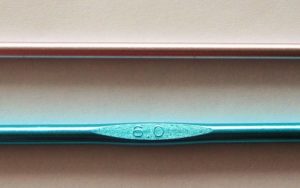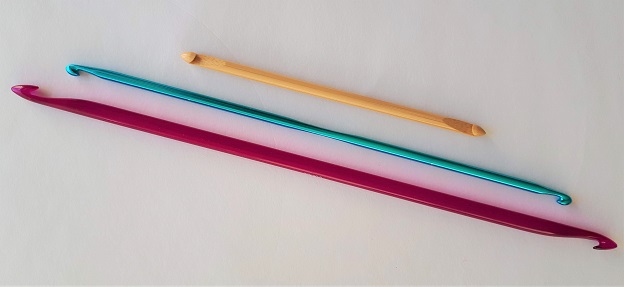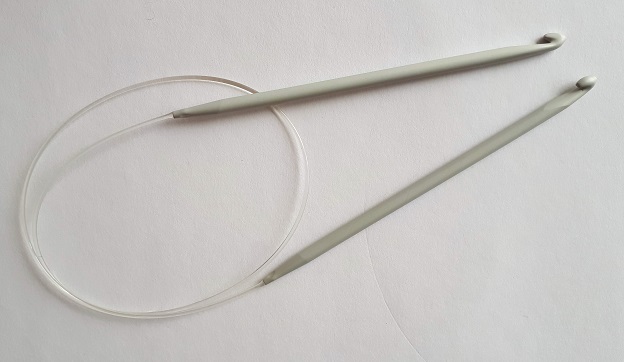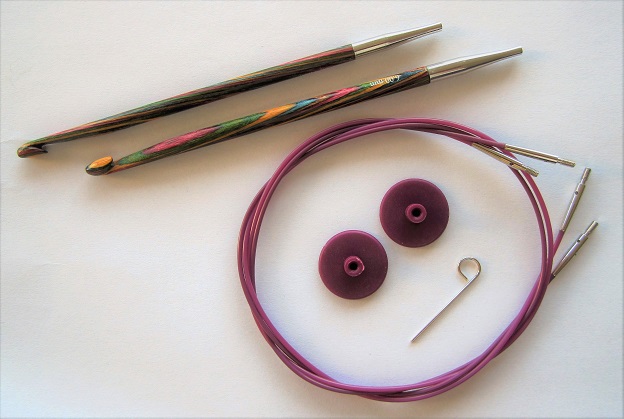There are many different types of double-ended Tunisian crochet hooks. Impossible to say which one is the best. Up to you to choose what you prefer to work with: straight or with a cable, short, long, made of wood or in metal, round or pointy head…
Small differences between similar hooks

On the above photo I show 2 similar hooks. Yet, if you have a close look at them, you’ll notice a few differences.
Some hooks (here in pink) have heads oriented in opposite directions. One head is turned face up (on the right), the other head is turned face down (on the left). Technically, you pick up loops on the FwdP with the head oriented upward and you work loops off the hook on the RetP with the head facing downward. The idea is that you don’t have to twist the hook when you turn your work. I’m personally not convinced it makes a difference.

Other hooks (here in blue) have a thumb-rest in the middle of the shank. See that flat part where the hook size is usually engraved. I don’t believe it has any ergonomic advantage. Yet it does not have any impact (or so little) on how loops move on the hook.
Different hook sizes in one hook

Some double-ended hooks have a different size at each end. See the above hook from Knit Pro Symfonie. Clearly the difference is not huge and in practice this hook could do the trick. But I believe this hook is not meant to be a Tunisian crochet hook. It is meant to be used in “standard” crochet projects (“standard” as opposed to “Tunisian”). It looks more like a “2-in-1” than a “double-ended” hook.
Length of the hook

Whether the hook is short or long, this does not limit the size of your project. You can make small or big projects with any length of hook. Above all it’s a question of comfort, how you feel when handling a short or long hook. Just keep in mind that if you have a project with long rows, you’ll need to turn your work more often with a short hook than with a longer hook. Practically this will slow down the pace at which you progress on your project.
I personally prefer medium straight hooks when I use thick yarn. The weight of the project is more evenly spread over the hook. But I prefer short hooks for small projects I carry in my bag, like beanies or cowls.
Double-ended hooks with cables (circular)

You may come across hooks with a fixed cable (photo above). But I would recommend that you invest in hooks with interchangeable cables instead. You would be able to adapt the length of the cable to the need of different projects. That is more comfort and flexibility for you.

I like straight double-ended hooks (so without cables). However you don’t have to invest in this special type of hook. You can “make” your own double-ended hook with a set of interchangeable hooks. You just need to make sure you can attach a hook to both sides of the cable (which is often the case, but always check).
If you don’t have the same hook size twice in your set, opt for 2 hook sizes that are close to each other (a difference of 0.5 mm). If you work in rounds, use the bigger hook to pick up loops on the FwdP and use the smaller hook to work loops off the hook on the RetP.
Other option: you buy a second hook of the same size, let’s say the size that you use most.
Other option: You use the same hook at both ends. Simply take it off one end and put it on the other end each time you need to turn your work and use the other end. Frankly, pfff… That is laborious…
